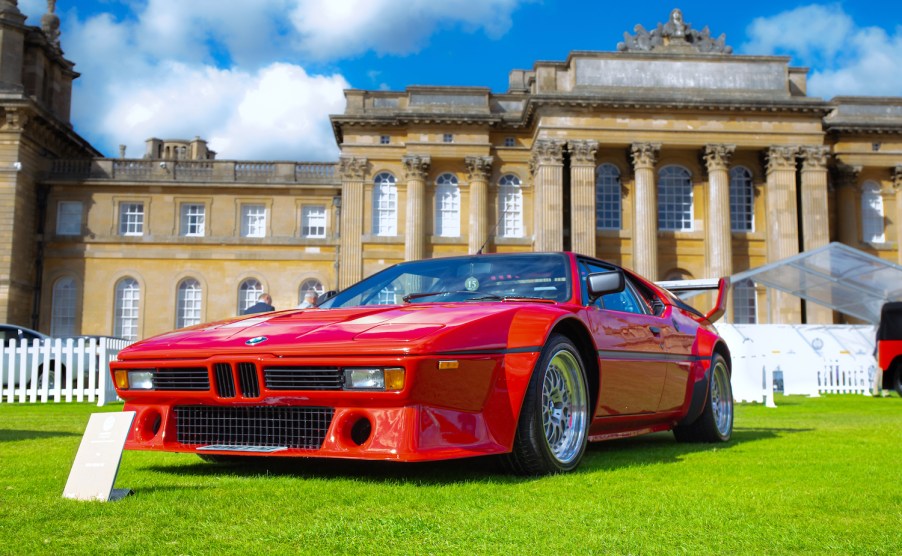
BMW M1: The History Behind BMW’s First-Ever Mid-Engine Supercar
In the 1970s, Porsche’s 911 dominated the international racing scene, and Stuttgart’s engineers proudly represented what Germany had to offer in automotive competition on the track and showroom floor. Three hours southwest, however, Porsche’s Bavarian brethren at BMW looked to build Munich’s answer to Group 5 racing – the BMW M1. Yet, the brand’s creation was fraught with production turmoil and ended up essentially useless for what it was designed to accomplish.
Why build a mid-engine supercar?

The motorsport division of BMW, headed by Jochen Neerpasch, emphasized a mid-engine design for the Group 5 car to surpass its competitors. Paul Rosche, who would later design the 6.1-liter V12 in the McLaren F1, was called upon to create the M88/1 powerplant for their race car, the BMW M1.
Rosche came up with a 3.5-liter straight-six with six separate throttle bodies, four valves per cylinder, and twin cams to generate 277 hp and 243 lb-ft of torque—in the road-going version. That doesn’t sound like much, but since the M1 was made of fiberglass, it weighed just over 3,000 pounds. Consequently, it was light enough to achieve 0-60 in 5.8 seconds on the way to a top speed of 161 mph.
Was the M1 a “real” BMW?
Less than five years after the Lamborghini Miura shocked the world as the first mid-engine supercar, BMW was already planning something similar. Developed by BMW’s Paul Bracq, the BMW Turbo Concept has all the streamlining of the later M1, but featured rear wheel skirts to improve its low-slung stance and aerodynamics further. Only two models were ever built, Hot Cars reports, but the final M1 design would feature much more Italian DNA.
For the M1 to qualify to race, FIA rules demanded BMW make 400 road-going versions sold to the public, known as homologations. Since the company had to rush to complete the M1, they had to get Italdesign’s Giorgetto Giugiaro—famous for the Miura—to design the M1 and Lamborghini to do the engineering and production work.
However, during their work for BMW, Lamborghini went bust for the second time in 1977, meaning BMW had to begin again, says U.S. News & World Report. Although the story is unconfirmed, the tale goes that BMW had to break into the government-locked Lamborghini factory in the middle of the night to take back the body molds. Otherwise, the receiver would have sold them for scrap.
In the following months, Neerpasch rushed to find new partnerships, and a deal was struck with Marchesi in Modena to assemble the space frame chassis. At the same time, Italian composites maker TIR would lay the body panels, MotorTrend states. Italdesign agreed to fasten the bodies to frames at its headquarters, and the unassembled M1s would be sent to Stuttgart for further assembly by automotive constructor Baur and shipped back to BMW Motorsport in Munich for inspection.
Was the BMW M1 a successful racer?

Once the BMW M1 was complete, a slew of mechanical failures plagued the racing division. In its few years in Group 4, Group 5, GTX, and Group B, the M1 suffered constant DNFs. The most successful finishes were in the 1979 24 Hours of Le Mans when the Group 4 M1 “Art Car” hand-painted by Andy Warhol qualified third but finished sixth, Market Motorsports reports. Yet, it would take first and second in the 1981 IMSA GTO class championship.
As rules for Group 5 changed, the car became less competitive, and in 1982, Group 5 ended. To salvage the work put into the M1, Neerpasch devised a one-make championship using modified M1s to aid the company in building enough cars to enter the Group 4 classification. The Procar BMW M1 Championship served as a support racing series for Formula One drivers. Upon meeting the standard for Group 4, the M1 Procars were used for multiple teams.
How many BMW M1s were built, and how much are they now?
In its short production life from 1978 to 1981, just 453 M1s were built, The Drive states. Fifty-three examples were used in the various racing ventures, and 400 were sold to customers. Like all homologation race cars, the BMW M1 is rare. In fact, many have never seen one in the metal. Therefore, like all rare cars, they carry a hefty price tag.
Hagerty reports that a “good condition” M1 can fetch $440,000. Out of the previous 65 sales they’ve accounted for, the highest went for $605,000, and the most recent brought $566,000.
What does the M1 leave behind?
Unfortunately, a troubled birth and FIA rule changes made it so the M1 never got to shine as much as Neerpasch hoped it would. Nevertheless, while this car is relegated to the under-sink cupboard of automotive history, part of it still lives on. It was BMW’s first production car to feature the esteemed “M” badge, the genesis of one of the best lines of sportscars ever made.


